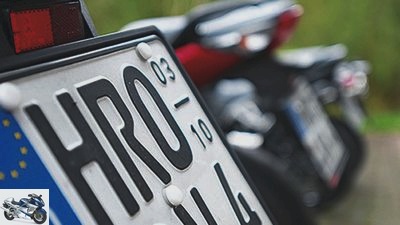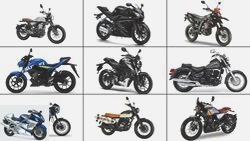Table of contents
- Inexpensive entry into car insurance Insure a motorcycle, but do not ride it
- The policyholder does not have to be the holder
- When is the no-claims discount transferable?

Sdun
counselor
traffic & business
Motorbike insure cheaper entry car insurance
Inexpensive entry into car insurance
Insure a motorcycle, but do not ride it
The longer a driver is on the road without damage, the higher the no-claims class. It saves money. How new drivers can get started with a relatively cheap insurance tariff and what needs to be considered.
Dina Dervisevic
02/07/2019
Accident-free driving is rewarded by the motor vehicle insurance. The safest way to drive without an accident is: not to drive at all. Which is why some resourceful parents register an inexpensive motorcycle with a displacement of 80 cc or more, in order to enable their youngsters to take out car insurance at a cheaper rate.
How exactly does it work? Take a motorized two-wheeler, trike or quad that has a displacement of at least 80 cm³ and can be approved. It is best to avoid the 125cc displacement class, because they are usually more expensive in insurance, as it is popular with young motorcycle beginners. Something more mature with around 200, 250 cm³ cubic capacity and as little power as possible can bring a contribution rate of just 20 euros per year. This is a cheap way to buy damage-free years.

Driving experience & Driving tips
Driving school forms for all classes
Take the driver’s license test!
read more

traffic & business
Motorcycle driving license class A, A2, A1
All information about costs, classes, courses
read more

motorcycles
125 with Euro 4
Motorcycles for A1 and class B (code number 196)
read more
The policyholder does not have to be the holder
And how does the driver license holder get the resulting no-claims discount? This possibility arises from the fact that the policyholder does not automatically have to be the owner of the vehicle. With regard to a later transfer, however, the policyholder should be related to the driver license holder, who should later benefit from the percentages (see below). One of these people registers the vehicle with the vehicle insurance company. Every year in which the vehicle remains damage-free, it rises one level higher in the no-claims class (SF) and the contract continues with a higher no-claims discount.
In principle, vehicles from other owners can also be insured on this contract – the policyholder and vehicle owner must of course agree on this, because the invoice is first sent to the policyholder.
When is the no-claims discount transferable?
In principle, it is also possible for the vehicle owner to take over the contract or the no-claims discount. But the transfer of SF classes is not unconditional. It is almost always possible to transfer the SF class to one’s own children, spouse or parents. However, many insurance companies also allow it for the significant other, non-biological children or grandchildren.
Often, but not always, the insurance also requires that the recipient of the no-claims bonus has regularly driven the car whose no-claims bonus is to be transferred. Some companies also require the recipient to be registered as the main driver. So if you take out insurance with the aim of later transferring the SF discount, you should ask the provider how he will handle this before signing the contract.
But beware: Only as many claim-free years can be transferred as the recipient has his driver’s license.
Seasonal license plates: The insurance premium is even lower with a seasonal license plate, but the vehicle must have been insured for at least 180 days, six months or over six months – depending on the insurance company – in order to count claims-free years.
Backdating: If a vehicle is only registered in August or later, the policyholder does not enter the next higher SF class by January next, as the insurance contract must have existed for at least six months. It is often worthwhile to backdate the contract to July 1st or earlier – depending on the insurance company.
Tax: There are no taxes for a motorcycle with a displacement of 125 cc or less – unless the vehicle has an output of more than 11kW (15 HP). Then the normal motorcycle tax would also be due for a light motorcycle between 50 and 125 cm³: for every 25 cm³ or part thereof, this is 1.84 euros vehicle tax per year.
Claims-free years: these are normal calendar years, i.e. a period of 12 months. The no-claims class is based on the no-claims years. Example: Anyone who has not reported any damage for two years – and started at SF 4 – is upgraded to no-claims class 6 (SF 6). The higher the SF, the lower the contribution rate can be. Can, but doesn’t have to. At least not right away. This is because several SF classes can also share a contribution rate.
Insurance contribution: The amount is based on the contribution classes for liability and comprehensive insurance. And every insurance company calculates differently. The discount scales also differ within an insurance company. With wgv, for example, the lowest contribution rate of 30 percent is achieved with a motorcycle after seven damage-free years (SF 7), with a car it is 22 damage-free years (SF 22). The percentage of the lowest contribution rate is also decided by each insurance company for itself.
Different contribution rates: Insurance companies include motorcycles and cars in the same vehicle group – the claims history can therefore be transferred – but that does not mean that the same contribution rates apply. For motorcycles, the contribution rates are often a little higher in liability insurance, but lower in comprehensive insurance. So if the junior takes over the SF 4, for example, which means 39 percent contribution rate for liability for motorcycles and 44 percent for fully comprehensive insurance, this can mean 52 percent contribution rate for SF 4 for cars and 45 percent for fully comprehensive insurance.
Second car: If a vehicle is to be registered as a second vehicle for a driver license holder, it is essential to ensure that it is not excluded by an applicable minimum age limit. If the offspring would like to have the loss experience transferred to themselves later, only the SF of the second car can of course be transferred.
Moped or moped: There are individual insurance companies that grant a discount if the driver license holder can prove that he has been driving a moped or moped for at least twelve months without any damage. There is often a fixed period between the expired moped contract and the new car insurance, which must not be exceeded.
Incidentally, it also works the other way round: When it comes to car insurance, there is often a senior surcharge from the age of 65. This can be avoided by having the vehicle insured by someone younger.
Related articles
-
Motorcycle insurance rates comparison 2018
Fotolia counselor traffic & business Motorcycle insurance rates comparison 2018 Motorcycle insurance rates comparison 2018 Top offers for 2018 Put your…
-
Motorcycle insurance: insurance terms translated
Fotolia / DDRockstar counselor traffic & business Motorcycle insurance: insurance terms translated Insurance terms translated What does that mean in…
-
Motorcycle license costs classes A2 driving school forms
Natalie Diedrichs 9 pictures Bilski 1/9 The motorcycle license is not only a permit to drive on public premises, but also for many people the ticket to…
-
Insurance tariffs 2015 for motorcycles
counselor traffic & business Insurance tariffs 2015 for motorcycles Insurance tariffs 2015 for motorcycles The performance must also be right A cheap…
-
Service: Insurance tariffs 2017
Jakub Jirsk, Fotolia counselor traffic & business Service: Insurance tariffs 2017 Service: Insurance tariffs 2017 Full coverage First they promise the…
-
Motorbike rental in southern Europe and Turkey
Iron ham to travel Motorbike rental in southern Europe and Turkey Motorbike rental in southern Europe and Turkey Escape agent No question about it, there…
-
Motorbike Museum Schloss Augustusburg
to travel Augustusburg Castle Motorcycle Museum Scene: Augustusburg Castle Motorcycle Museum 175 motorcycles from almost 125 years Content of 50 years…
-
Drive 125cc with the car driver’s license without a test
Honda 20th pictures KTM 1/20 1st place: KTM 125 Duke with 5,334 new registrations in 2020. Yamaha 2/20 2nd place: Yamaha MT-125 with 2,439 new…
-
Motorbike rentals in Australia and New Zealand
to travel Motorbike rentals in Australia and New Zealand Motorbike rentals in Australia and New Zealand Biking down under Where better to escape the…
-
Foil label: Insurance label to stick on
GDV counselor traffic & business Foil label: Insurance label to stick on Foil license plate for mopeds from March 2021 Insurance number to stick on The…